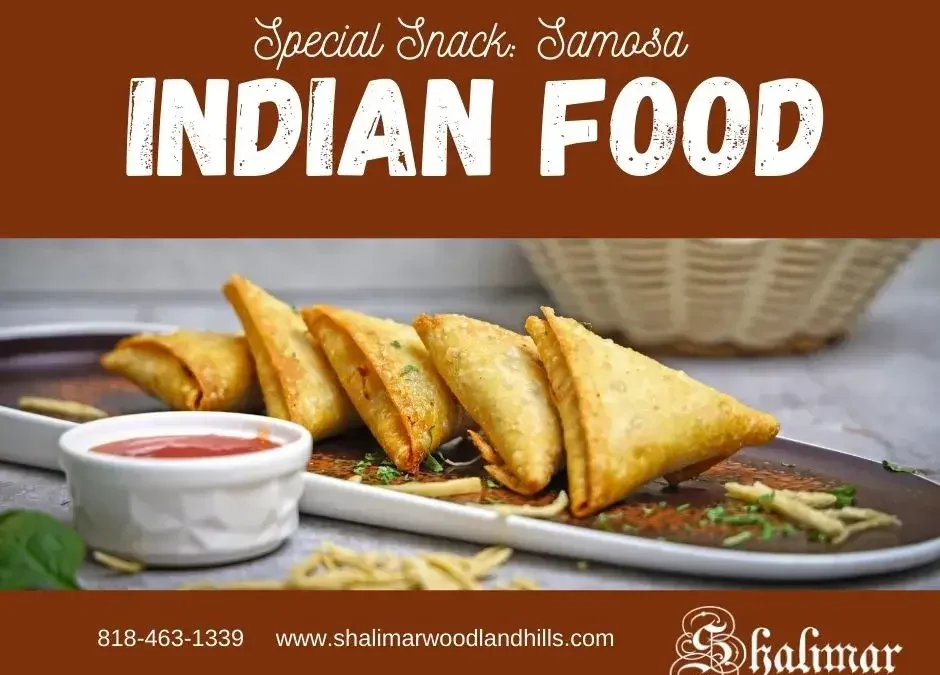
Your Guide to Indian Restaurant Ingredients: Spices, Herbs, and More
January 17, 2025
Why Samosa is the Ultimate Indian Food Street Snack
February 7, 2025If there is one Indian food snack that has captivated taste buds worldwide, it is the samosa. Legend has it that travelers along the Silk Road carried early versions of this crispy delight as a convenient, energy-packed meal, making it a beloved treat across cultures. This crispy, golden-brown pastry filled with spiced potatoes, peas, and sometimes meat or lentils, is a beloved street food and household favorite in India and beyond. Whether served with tangy chutneys or enjoyed as a stand-alone treat, samosas offer a perfect balance of crunch, spice, and flavor. But what makes this simple yet delicious snack so special? Let’s dive into the history, preparation, and cultural significance of the samosa.
The Origins of Samosa in Indian Food
The samosa’s history can be traced back to Central Asia and the Middle East, where early versions of the snack—known as “sambusak” or “sanbosag”—were filled with minced meat and enjoyed as a convenient, portable meal. When the samosa made its way to India, it underwent a significant transformation, with local cooks replacing the meat-based filling with mashed potatoes, peas, and a blend of aromatic spices. This adaptation was heavily influenced by the abundance of vegetarian cuisine in India, making the dish more accessible and widely consumed. The dough also became crispier and flakier due to the use of ghee, enhancing the texture and flavor. as “sambusak” or “sanbosag”—were filled with minced meat and enjoyed as a convenient, portable meal. As traders and travelers carried the dish to the Indian subcontinent, it was embraced and transformed using locally available ingredients, primarily potatoes and spices. Today, samosas are an integral part of Indian cuisine and are found in different variations across South Asia, the Middle East, and even parts of Africa.
What Makes a Samosa Special?
A samosa consists of three essential elements:
- The Dough – Made from all-purpose flour, the dough is kneaded with water, salt, and a touch of oil or ghee to create a firm but pliable consistency. It is then rolled out and shaped into a cone to hold the filling.
- The Filling – Traditional Indian samosas contain mashed potatoes, peas, and aromatic spices like cumin, coriander, garam masala, and chili powder. Some variations include lentils, paneer, chicken, or lamb, depending on regional preferences.
- The Cooking Method – Samosas are deep-fried until they turn crisp and golden brown. Some health-conscious variations involve baking or air-frying for a lighter alternative.
Variations Across Regions
The samosa has evolved in different ways across the world:
- India – Classic potato-filled samosas, often served with tamarind and mint chutney.
- Pakistan – Spicier versions, sometimes stuffed with ground beef or lentils.
- Africa – Known as sambusas, these are popular in countries like Kenya and Tanzania, with fillings ranging from spiced vegetables to meat.
- Middle East – Typically filled with minced meat, cheese, or nuts.
Why You Should Try a Samosa in Indian Food
Samosas are not just a delicious snack; they represent a fusion of cultures and traditions. They are perfect for any occasion—whether as a street food delight, a party appetizer, or a comforting homemade treat. With the availability of different fillings and cooking methods, there is a samosa for every palate and dietary preference.
According to renowned Indian chef Sanjeev Kapoor, “The samosa is more than just a snack; it is a symbol of India’s love for bold flavors and rich textures. Whether crispy and spicy or mild and flaky, there is always a version to suit your taste.”
If you’re new to samosas, consider starting with a classic potato-filled one from an authentic Indian restaurant. For a unique experience, try regional variations like Keema samosas filled with spiced meat or sweet versions made with coconut and jaggery. Samosas are not just a delicious snack; they represent a fusion of cultures and traditions. They are perfect for any occasion—whether as a street food delight, a party appetizer, or a comforting homemade treat. With the availability of different fillings and cooking methods, there is a samosa for every palate and dietary preference.
If you haven’t tried a samosa yet, now is the time! This beloved Indian food is a perfect blend of crunch, spice, and tradition. Whether you make them at home using easy-to-follow recipes from popular Indian chefs or grab one from renowned Indian restaurants like Bikanervala or Haldiram’s, this iconic snack is sure to leave a lasting impression. The perfect combination of crispiness, spice, and rich flavors makes the samosa an unforgettable culinary experience. Are you ready to take a bite? you haven’t tried a samosa yet, now is the time! Whether you make them at home, grab one from an Indian restaurant, or explore street vendors in an Indian market, this iconic snack is sure to leave a lasting impression. The perfect combination of crispiness, spice, and rich flavors makes the samosa an unforgettable culinary experience. Are you ready to take a bite?

